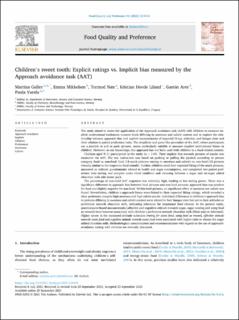| dc.description.abstract | The study aimed to assess the application of the Approach avoidance task (AAT) with children to measure implicit motivational tendencies towards foods differing in sweetness and calorie content and to explore the relationship between approach bias and explicit measurements of expected liking, attitudes, and hunger state and their relation to paired-preference tasks. The simplicity and game-like procedure of the AAT, where participants use a joystick to pull or push pictures, seems particularly suitable to measure implicit motivational biases in children. However, to our knowledge, this approach has not been used with children in a food related context. Children aged 9–11 participated in the study (n = 114). Their implicit bias towards pictures of snacks was measured via AAT. The test instruction was based on pushing or pulling the joystick according to picture category, food vs. non-food: food (18 snack pictures varying in sweetness and calorie) vs. non-food (18 pictures visually similar to the respective food stimuli). Further, children rated their expected liking of the snack pictures, answered an attitude questionnaire related to health and sugar consumption, and completed two paired preference tests tasting real samples under blind condition and choosing between a sugar and no-sugar added chocolate milk take-home pack. The percentage of non-valid AAT responses was relatively high, leading to low testing power. There was a significant difference in approach bias between food pictures and non-food pictures; approach bias was positive for food and slightly negative for non-food. Within food pictures, no significant effect of sweetness nor calorie was found. Nevertheless, children’s approach biases were linked to their expected liking ratings, which revealed a clear preference towards high sweetness and high calorie snacks. Individual differences in children’s approach bias to pictures differing in sweetness and calorie content were related to their hunger state but not to their attitudes or preference towards chocolate milk, indicating relevance for situational food choices. In the present study, questionnaire-based measurements (affective and cognitive attitude towards sugar, sugar craving and using food as reward) were however associated with children’s preference towards chocolate milk (blind and/or informed). Higher scores in the measured attitude subscales craving for sweet food, using food as reward, affective attitude towards sweet food and cognitive attitude towards sweet food were associated with higher odds to choose the sugar added chocolate milk. Methodological considerations and recommendations with regards to the use of approach-avoidance testing with children are critically discussed. | |
